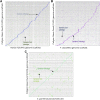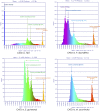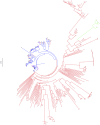De Novo Genome Sequence Assembly of Dwarf Coconut (Cocos nucifera L. 'Catigan Green Dwarf') Provides Insights into Genomic Variation Between Coconut Types and Related Palm Species
- PMID: 31167834
- PMCID: PMC6686914
- DOI: 10.1534/g3.119.400215
De Novo Genome Sequence Assembly of Dwarf Coconut (Cocos nucifera L. 'Catigan Green Dwarf') Provides Insights into Genomic Variation Between Coconut Types and Related Palm Species
Abstract
We report the first whole genome sequence (WGS) assembly and annotation of a dwarf coconut variety, 'Catigan Green Dwarf' (CATD). The genome sequence was generated using the PacBio SMRT sequencing platform at 15X coverage of the expected genome size of 2.15 Gbp, which was corrected with assembled 50X Illumina paired-end MiSeq reads of the same genome. The draft genome was improved through Chicago sequencing to generate a scaffold assembly that results in a total genome size of 2.1 Gbp consisting of 7,998 scaffolds with N50 of 570,487 bp. The final assembly covers around 97.6% of the estimated genome size of coconut 'CATD' based on homozygous k-mer peak analysis. A total of 34,958 high-confidence gene models were predicted and functionally associated to various economically important traits, such as pest/disease resistance, drought tolerance, coconut oil biosynthesis, and putative transcription factors. The assembled genome was used to infer the evolutionary relationship within the palm family based on genomic variations and synteny of coding gene sequences. Data show that at least three (3) rounds of whole genome duplication occurred and are commonly shared by these members of the Arecaceae family. A total of 7,139 unique SSR markers were designed to be used as a resource in marker-based breeding. In addition, we discovered 58,503 variants in coconut by aligning the Hainan Tall (HAT) WGS reads to the non-repetitive regions of the assembled CATD genome. The gene markers and genome-wide SSR markers established here will facilitate the development of varieties with resilience to climate change, resistance to pests and diseases, and improved oil yield and quality.
Keywords: Cocos nucifera L.; Dovetail Chicago sequencing; Illumina Miseq Sequencing; PacBio SMRT sequencing; SSR and SNP markers; dwarf coconut; genome assembly; hybrid assembly.
Copyright © 2019 Lantican et al.
Figures





Similar articles
-
Improving Coconut Using Modern Breeding Technologies: Challenges and Opportunities.Plants (Basel). 2022 Dec 7;11(24):3414. doi: 10.3390/plants11243414. Plants (Basel). 2022. PMID: 36559524 Free PMC article. Review.
-
Assembly and Annotation of the Nuclear and Organellar Genomes of a Dwarf Coconut (Chowghat Green Dwarf) Possessing Enhanced Disease Resistance.OMICS. 2020 Dec;24(12):726-742. doi: 10.1089/omi.2020.0147. Epub 2020 Nov 10. OMICS. 2020. PMID: 33170083
-
The genome draft of coconut (Cocos nucifera).Gigascience. 2017 Nov 1;6(11):1-11. doi: 10.1093/gigascience/gix095. Gigascience. 2017. PMID: 29048487 Free PMC article.
-
Mining and validation of novel simple sequence repeat (SSR) markers derived from coconut (Cocos nucifera L.) genome assembly.J Genet Eng Biotechnol. 2022 May 16;20(1):71. doi: 10.1186/s43141-022-00354-z. J Genet Eng Biotechnol. 2022. PMID: 35575943 Free PMC article.
-
Unveiling the Secrets of Oil Palm Genetics: A Look into Omics Research.Int J Mol Sci. 2024 Aug 7;25(16):8625. doi: 10.3390/ijms25168625. Int J Mol Sci. 2024. PMID: 39201312 Free PMC article. Review.
Cited by
-
Redox-related gene expression and sugar accumulation patterns are altered in the edible inflorescence produced by the cultivated form of pacaya palm (Chamaedorea tepejilote).Ann Bot. 2021 Jul 30;128(2):231-240. doi: 10.1093/aob/mcab060. Ann Bot. 2021. PMID: 33978714 Free PMC article.
-
A Chromosome-level Reference Genome of African Oil Palm Provides Insights into Its Divergence and Stress Adaptation.Genomics Proteomics Bioinformatics. 2023 Jun;21(3):440-454. doi: 10.1016/j.gpb.2022.11.002. Epub 2022 Nov 24. Genomics Proteomics Bioinformatics. 2023. PMID: 36435453 Free PMC article.
-
Applications of Optical Mapping for Plant Genome Assembly and Structural Variation Detection.Methods Mol Biol. 2022;2443:245-257. doi: 10.1007/978-1-0716-2067-0_13. Methods Mol Biol. 2022. PMID: 35037210
-
Improving Coconut Using Modern Breeding Technologies: Challenges and Opportunities.Plants (Basel). 2022 Dec 7;11(24):3414. doi: 10.3390/plants11243414. Plants (Basel). 2022. PMID: 36559524 Free PMC article. Review.
-
Utilizing CRISPR-Cas in Tropical Crop Improvement: A Decision Process for Fitting Genome Engineering to Your Species.Front Genet. 2021 Nov 12;12:786140. doi: 10.3389/fgene.2021.786140. eCollection 2021. Front Genet. 2021. PMID: 34868276 Free PMC article.
References
-
- Abraham A., and Mathew P. M., 1963. Cytology of coconut endosperm. Ann. Bot. 27: 505–512. 10.1093/oxfordjournals.aob.a083866 - DOI
-
- Al-Ghazi Y., Bourot S., Arioli T., Dennis E. S., and Llewellyn D. J., 2009. Transcript profiling during fiber development identifies pathways in secondary metabolism and cell wall structure that may contribute to cotton fiber quality. Plant Cell Physiol. 50: 1364–1381. 10.1093/pcp/pcp084 - DOI - PubMed
-
- Al-Salih A. A., and Al-Rawi A. M. A., 1987. A study of the cytology of two female cultivars of date palm. Date Palm J. 5: 123–142.
Publication types
MeSH terms
Substances
LinkOut - more resources
Full Text Sources
Research Materials
Miscellaneous
